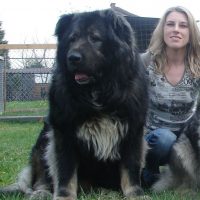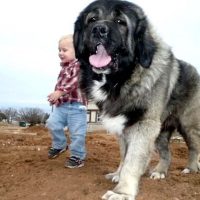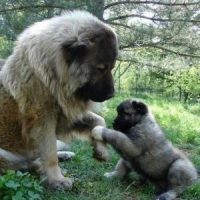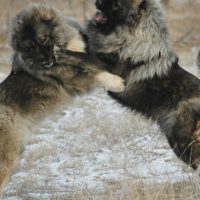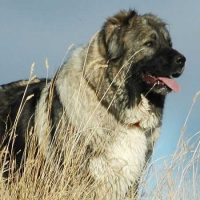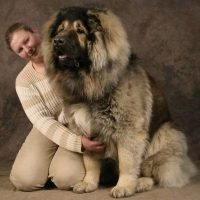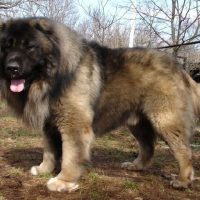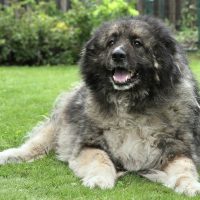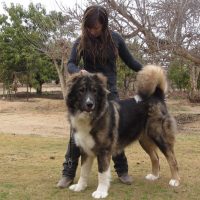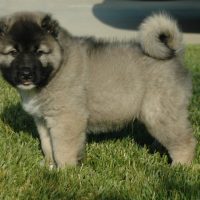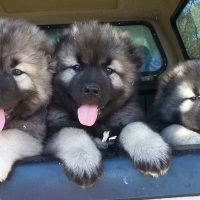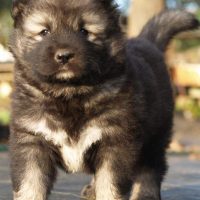Caucasian Ovcharka dogs were mainly bred for centuries to protect properties and flocks, from trespassers, guard livestock, against large and small predators such as bears wolves and coyotes, and for many other duties. In modern days, especially in the West, this dog breeds are mostly used as watchdogs.
Other names for the breed include Caucasian Shepherd, Caucasian Sheepdog, Kawkasky Owtscharka, and Kaukasische Schaferhund. In Russian, they are called Кавказская Овчарка or Кавказский Волкодав.
The Appearance of Caucasian Ovcharka Dogs
The Caucasian Ovcharka is a powerful, strongly muscled, and heavily boned in proportion to height.
It’s a wide-headed which is wedge-shaped, and tapers slightly to a blunt muzzle with high-set hanging ears, which may be cropped, and deep-set, oval-shaped eyes.
The thick tail hangs down to the hock but may be carried above the back as a sickle-shaped hook or ring when the dog is excited or moving.
The coat colors vary and include shades of gray, fawn, and reddish, with white markings and often a dark facial mask.
Caucasian Ovcharka Pictures
Quick Information ~ Caucasian Ovcharka Dogs
| Characteristics | Details |
|---|---|
| Name | Caucasian Ovcharka |
| Other Names | Caucasian Shepherd Dog, Caucasian Sheepdog, Kawkasky Owtscharka, Kaukasische Schaferhund |
| Color | Combinations of Gray, white, brindle, tan, fawn or pied |
| Coat | Long and Dense |
| Breed Group | Flock Guard (Sheepdog) |
| Size | Large |
| Hieght | 64 – 72 cm |
| Weight | 99-170 Pounds |
| Life Span/Life Expentancy | 10-12 Years |
| Temperament | Fearless, Strong-willed, courageous, Loyal, and Alert |
| Shedding | Seasonal (Twice a Year) |
| Hypoallergenic | No |
| Barking Level | Medium |
| Good with Children | No |
| Litter Size | 3-10 puppies |
| Country of Origin | Russia |
| Competitive Registration/Qualification Information | FCI, NKC, CKC, APRI, ACR, DRA, NAPR, AKC/FSS, ACA |
History of Caucasian Ovcharka
It’s believed that the Caucasian Shepherd dogs have been around for more than 2,000 years. Although its first official Show-Ring appearance outside the Caucasus was in the 1930s in Germany, the Caucasian Mountain Dog has existed since ancient times, like many Eastern Molossers.
It is believed they might be related to the Tibetan Mastiff or the Anatolian Shepherd. Many types of research show the Caucasian dog as being a close relative of sheepdogs of the Balkans and mastiffs of Asia.
In ancient times the Caucasian Ovcharka Dogs were used for the guarding and safe-keeping of herds, flocks, and dwellings from predators.
Now, Caucasian shepherd dog is a fully standardized breed recognized by the major kennel organizations, including FCI, AKC, and UKC.
Types of According to Coat Type
For almost a century, there has been two breed types and standards:
The Mountain Type: The long-coated variety and has a heavier body mass than the other one.
The Steppe Type: The short-coat variety or, the Kazbek types with lighter body mass.
Temperament and Behavior
The Caucasian Mountain dog is a confident, bold, fearless, and fierce when a threat is present, but he is soft, devoted, kind and endearing to his family,
These dogs are very strong and are considered an extremely intelligent breed with a big instinct to protect anyone in the family including pets, livestock, making excellent watchdogs and livestock guard dogs.
The Ovcharka is incredibly loyal to his owners but fierce in their defense. They are not high energy dogs, but their size demands space, and so they are usually not recommended for apartment life.
It is recommended not leave them alone with children, else they might mess trying to be over-protective. They are not too friendly with strangers but would welcome family friends. However, properly trained ones have earned obedience and Canine Good Citizen titles, and some are even therapy dogs.
Care
Exercise
Exercise, daily walks and playtime should be a crucial part of the Caucasian Shepherd dog daily routine life to help prevent obesity.
Outdoor activities such as hiking, chasing balls and retrieving flying discs can be a good outlet of releasing energy.
Even though it is a low energy dog, he should have good endurance for walking and hiking. Some breeders encourage endurance tests.
Grooming
The Caucasian Shepherd has a variety of coat types, Long and Short.
The coat of the long-haired variety requires frequent brushings, paying special attention to the spots where tangles may occur. Longer-coated dogs need to be groomed daily.
The shorthaired variety needs less grooming, but should still be combed and brushed.
Their ears should be regularly checked to avoid a buildup of wax and debris which can result in an infection.
Their fast-growing nails should be trimmed regularly with a nail clipper or grinder to avoid overgrowth, splitting and cracking. Teeth should be brushed regularly.
Health Issues
The Caucasian Mountain Dog is generally healthy and long-lived with a lifespan of 10-12 years
However, like many giant dog breeds, they may suffer from some health issues in the form of
but the majority of these dogs are healthy if taken care of correctly.
Working with a responsible breeder, those wishing to own a Caucasian Shepherd can gain the education they need to know about specific health concerns within the breed.
Training
Caucasian Ovcharka dogs are usually not easy to train. This breed is very assertive and strong-willed and will need to be taught basic manners and good behavior from a very young age.
The Caucasian Ovcharka requires a very strong and confident leader that consistently exerts their place as head of the pack. So be sure to lead the dog while jwalking to ensure your own pack leadership.
Talk to his trainer about instituting a nothing-in-life-is-free program, requiring the puppy to “work” by performing a command before he receives toys, meals, treats or play.
Feeding/Diet
The huge Caucasian Ovcharka Dog has a huge appetite. You should feed this canine breed with high-quality food which should provide necessary nutrition.
Feed the young puppies 2-3 times a day, and adults 1-2 times daily. A high-quality dry dog food is also recommended for a healthy diet. Clean and fresh water in large bowls should be available at all times.
Feeding your dog is a personal choice, but working with your veterinarian and/or breeder will be the best way to determine the frequency of meals as a puppy and the best adult diet to increase his longevity.
Caucasian Ovcharka Puppies
The training of the pups should begin as early in life as possible, and socialization is practically a must.
Proper socialization training has to be done to overcome the breed’s apprehension around new people and animals, which can result in aggression.
And note that Ovcharka puppies are inveterate chewers, so don’t give them the roam of the house until they’ve reached maturity.
Caucasian Shepherd Puppies Pictures
Interesting Facts
In Russian, Ovcharka means “shepherd” or “sheepdog.”
Females only give birth once a year, which may hark back to the breed’s primitive beginnings.
Caucasian Ovcharka has been recorded in the Foundation Stock Service since 1996.
The ears of Caucasian Ovcharka dogs are traditionally cropped, although some modern Caucasian Ovcharkas are kept unaltered.
Video: The Caucasian Shepherd Ovcharka Dog
Difference Between Caucasian Shepherd and Caucasian Ovcharka
Caucasian Ovcharka and Caucasian Shepherd are two terms used for the same dog breed.
The name Caucasian shepherd is popular among the European community, whereas the term Caucasian Ovcharka is popular among Russian people.


